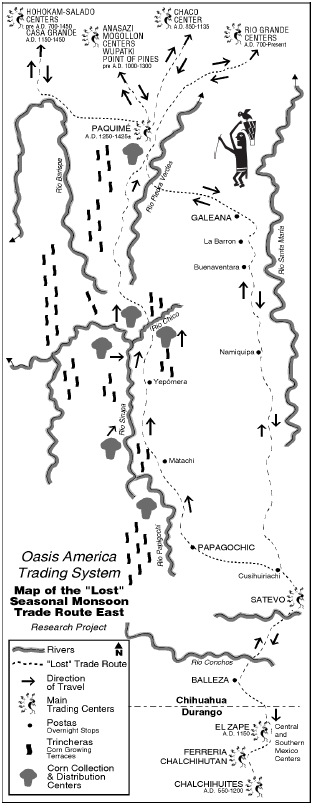 |
|||||||
 |
|||||||
| Scarlet Macaws occur in the humid tropical lowlands of southern Mexico. The macaws were moved in two distinct trips of 300-700 miles each. The first leg was from deep in Mesoamerica to Paquimé, Mimbres Valley or perhaps even Chaco and took less than eight weeks. The second leg of the journey was from the Mimbres/Paquimé trade center to Kiet Siel and Wupatki in northern Arizona. Young macaws, which hatch in March, must be removed from the nest at seven weeks old, carried in baskets, protected from chilling, and fed chewed hominy, often directly from the keeper’s mouth, every few hours, day and night, Once fledged, they can eat about anything a human can eat and have a moderate tolerance for cold. This early feeding relationship results in human-imprinted birds that are attached to their keeper, but often vicious to strangers. It is easier to capture new young birds than to breed adult macaws, because human-imprinted birds seldom recognize other parrots as potential mates. By the late 900s, Scarlet Macaws were being imported along a different trade route, running through the Mimbres River Valley to Chaco’s sphere of influence (34 macaws). Mimbres pottery motifs and the age of skeletal remains suggest that juvenile macaws were carried to the Mimbres sites, raised there for almost a year, and then traded north just in time for religious ceremonies at the spring equinox, which is March 21-22. From 1150 to about 1200 the trade in Scarlet Macaws branched west, probably at Zuni, to the Sinagua area (53 macaws). More Scarlet Macaws were recovered at Wupatki than at any other site north of Mexico. This sudden shift of ceremonial activity probably was precipitated by the repeated eruptions of Sunset Crater. The Scarlet Macaw trade became inactive in 1200 and did not resume until the Pueblo Katsina Cult arose around 1275. By this time, the Mimbres Villages were vacated and Paquimé had been built taking advantage of an already existing trade route. Paquimé specialized in raising juvenile Scarlet Macaws to a marketable size for trade to the later Rio Grande (9), Salado (5) and Mogollon (76). At least one Scarlet Macaw was hatched at Paquimé, but there is no evidence of a commercially successful breeding program at any site. Of the 504 macaws recovered from Paquimé, only 96 were the locally available Military Macaws. The only Military Macaw sacrifice found north of Paquimé was buried wrapped in turquoise beads under a green stone by the fire pit of a kiva in the Mimbres Valley Gatlin Ranch Site. The Scarlet Macaw produces feathers of vivid red, yellow, and blue, all of which were and are used in religious paraphernalia. Osteology indicates that the residents of Point of Pines (28 macaws) in east central Arizona traded large Indian domestic turkeys to Paquimé in return for Scarlet Macaws in the early 1300s. Charmion R. McKusick |
|||||||
 |
 |
||||||
copyright 2005 - Richard D Fisher - DigitalTeamWorks.com